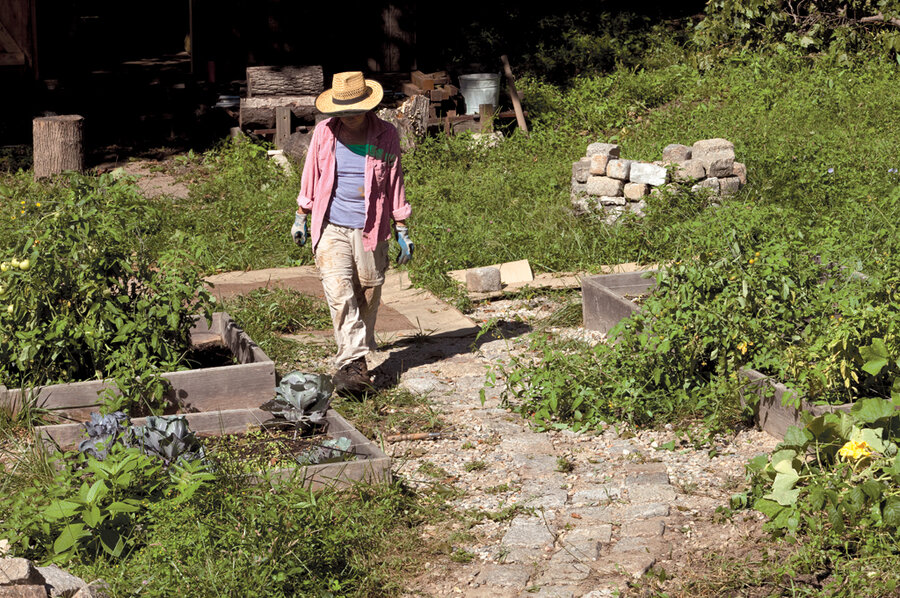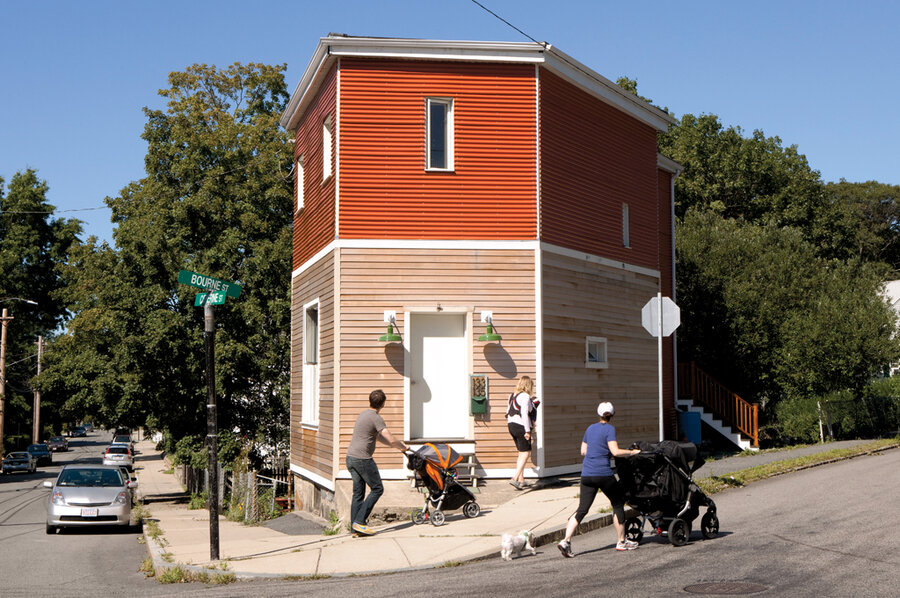The rise of urban farming
Greg Peterson's 1950s tract home looks like any other house on his block in Phoenix, with one notable difference: Practically everything in his yard is edible. More than 70 fruit trees reach for the sky. Chickens patrol for bugs in the yard. Late summer tomatoes, okra, and herbs such as basil and oregano punch fragrance into the air. Rain and gray water are harvested for watering, and solar panels on his house convert the sun's rays into energy.
Mr. Peterson calls his oasis of bounty on one-third of an acre "The Urban Farm." Once an anomaly among the manicured lawns in his neighborhood, Peterson's place has been so convincing an example over the past decade that scores of other suburban dwellers have traded decorative bushes for raised vegetable beds and straw-filled chicken coops.
"I started offering tours and classes at The Urban Farm every first Saturday [in 2001]. There were Saturdays where I would wait twiddling my thumbs ... for people to show up," Peterson recalls. "Now it is nothing for me to get 250 people ... for four different tours."
Meet the urban homesteader. Slowly, across the past decade, more Americans like Peterson have been proving that growing and preserving food is possible in all kinds of populated settings. City dwellers are practicing sustainable living at new levels beyond shopping for organic carrots and recycling bottles. Whether it is a tilapia farm in garden tubs in Kansas City, Mo., beekeeping in Chicago, or jars of homemade pickles in an apartment pantry in Austin, Texas, urban homesteaders are rebelling against the industrial food system by shouldering more of the responsibility for producing their own food.
"There is a population and culture that is finally saying that all this processed stuff is not good and the only way we can guarantee that food we use is safe is to grow it ourselves," says Joyce Miles, a family and consumer science expert in Maggie Valley, N.C., who traces the roots of modern urban homesteading back to the late 1880s.
While growing and preserving food in cities isn't new, these visionaries have elevated planting, composting, and canning to "retro hip" levels. It's a kind of trendy frugality fueled by a desire to be part of an environmental solution in a do-it-yourself era. Some urban home-steaders are home-schoolers who want to teach their children practical science skills. Others are simply trying to eat locally while reducing their food bill. Still others have repurposed domestic chores abandoned by their mothers and grandmothers into a fun hobby.
It is too soon to tell if this back-to-the-land mentality will be only a temporary balm for the anxiety of modern living. Victory gardens, after all, faded with the advent of peace after World War II when industrial food production turned again toward feeding families instead of troops. A homesteading movement in the 1970s was laughed out of existence as an idyllic but impractical response to the energy crisis. However, signs suggest, from the fashionable to the legislative, that today's hands-on engagement is here for the long haul. A few examples:
•Peterson estimates that between 2,000 and 3,000 urban farmers are raising food from Phoenix soil.
•On bucolic Bainbridge Island, off Seattle's coast, keeping chickens has become something of a fashion statement. In July, the island hosted its third annual "Tour de Coop" where visitors could tour participating backyard pens trimmed with artistic touches and, in one case, there was even piped-in classical music.
•Chicago will vote in September on an ordinance that could make growing and selling produce within city limits much easier, potentially giving new purpose to the city's estimated 14,000 empty lots.
These advances come in the midst of a struggling economy, a changing climate, a global food system in peril, rising food prices, concern over lax food safety, and dwindling resources. For homesteaders, cultivating a corner of the yard or the back deck into a tangle of edible things has become one small way to regain purpose and control in an unpredictable time.
While self-sufficiency was once a necessity on the American frontier, transforming an entire yard into an urban minifarm takes considerable time and effort. Harriet Fasenfest in Portland, Ore., who calls herself a "householder," says the key lies in small, incremental steps.
"People want to live this life as a householder but they don't really know what that involves," says Ms. Fasenfest, author of "A Householder's Guide to the Universe," which offers tips and instructions on everything from creating a garden plan and budget to the alchemy of jammaking.
Beyond endless weeding and battles with slugs and nibbling wildlife, urban farming isn't as easy as deciding to dig up your lawn. Zoning laws can restrict ambitions by ruling against the appearance of "messy" lawns and running farm stands out of the front yards. In Oak Park, Mich., Julie Bass made national headlines in July when she faced jail time for breaking city codes by constructing raised vegetable beds in front of her suburban house. Among the charges: The beds were "not common to a front yard." (The charge was later dropped.) Probably most challenging, however, is the fact that long hours of work can sometimes yield very little in results.
Andrée Collier Zaleska of Jamaica Plain, Mass., is homesteading on 1,000 square feet behind her energy-efficient house. It took her two years to rid the backyard of an invasive, creeping vine. But the effort was worth it. Her garden supports two families during the summer months. Terraced beds in late August were plump with kale, parsnips, cabbage, carrots, pumpkins, and broccoli. A chicken coop at the corner of the yard stood empty – the arrival of its would-be feathered residents halted by Boston zoning laws.
"I love the idea of the tiny urban lot bursting with life," says Ms. Zaleska, who spends about 20 hours a week in the garden in the spring, and 10 hours a week in the summer.
Zaleska, who cofounded her homestead with Ken Ward, runs her home as a nonprofit called the JP Green House. Designed to be a model of sustainable urban living, Zaleska gives educational tours and asks for donations on a website to support the venture. Figuring out how to make the JP Green House financially self-sustaining is an ongoing challenge, she admits.
"It doesn't make sense to spend 20 hours a week at a task that doesn't earn any money," she says, adding that she makes more money in her role as a community organizer and climate activist. But the rewards of homesteading – teaching her children practical skills, supplying their dinner from the garden, and the tangible joy the work provides – make it worth the effort.
"This is the fun part. I couldn't do the climate activism without [homesteading] because I'd be too depressed," she says.
But being an urban homesteader and mastering long-forgotten domestic skills doesn't require an overflowing garden. When Kate Payne moved to Brooklyn, N.Y., and was trying to make it as a freelance writer she had "zero reliable income." She started making bread and jam to save money, but found there weren't "a ton of resources" for domestic beginners so she started a blog called "The Hip Girl's Guide to Homemaking" as a way to chronicle her adventures and find a like-minded community.
"In my family, I didn't grow up doing this stuff," says Ms. Payne, who has since published a book with the same name as her blog and moved back to her hometown of Austin, Texas, where she teaches preserving and baking classes. "When I started canning for the first time I wanted to learn what other people were doing so I put out e-mails, tweets, and Facebook posts" trying to find people who were making their own pickles, yogurts, and cheeses.
It turns out there is a large community online of urban hipsters sharing their trials and triumphs. And people are wanting to share not only their tricks for keeping their container gardens watered while on vacation, but also their extra jars of strawberry jalapeño jam or tubs of rosemary-flavored yogurt.
Before Payne moved back to Texas, she and a friend set up a food swap in Brooklyn – essentially a silent auction where people bring their homemade goods and bid on others. The swap inspired one to get started in Portland, Ore., which in turn inspired one in Los Angeles. Her website lists cities across 20 states that now run food swaps.
This kind of sharing is exactly what Peterson advocates in his classes: It's a way for people to strengthen community connections and experience pride of accomplishment. "My goal is to tell as many people as possible how to grow food in the backyard and share it with your neighbors," he says. "Once you share food [you have produced], you are an urban farmer!"
[Editor's note: If you scroll down the page, you can find a urban farming online resource list.]







